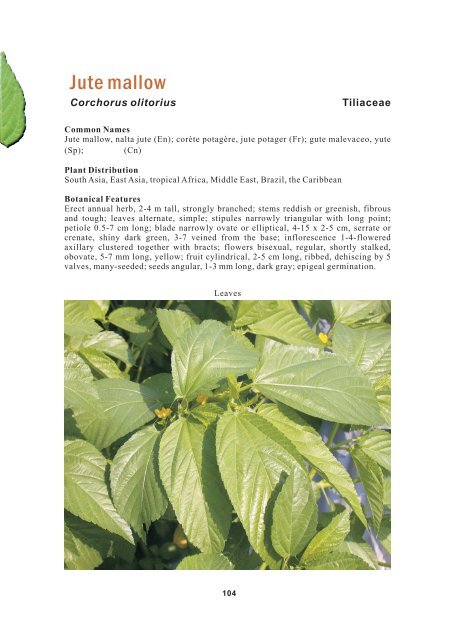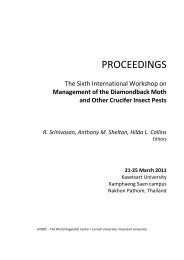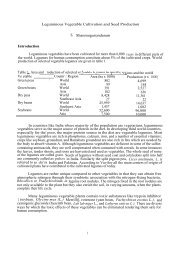Jute mallow
Jute mallow
Jute mallow
- No tags were found...
You also want an ePaper? Increase the reach of your titles
YUMPU automatically turns print PDFs into web optimized ePapers that Google loves.
<strong>Jute</strong> <strong>mallow</strong><br />
Corchorus olitorius<br />
Tiliaceae<br />
Common Names<br />
<strong>Jute</strong> <strong>mallow</strong>, nalta jute (En); corète potagère, jute potager (Fr); gute malevaceo, yute<br />
(Sp); (Cn)<br />
Plant Distribution<br />
South Asia, East Asia, tropical Africa, Middle East, Brazil, the Caribbean<br />
Botanical Features<br />
Erect annual herb, 2-4 m tall, strongly branched; stems reddish or greenish, fibrous<br />
and tough; leaves alternate, simple; stipules narrowly triangular with long point;<br />
petiole 0.5-7 cm long; blade narrowly ovateor elliptical, 4-15 x 2-5 cm, serrate or<br />
crenate, shiny dark green, 3-7 veined from the base; inflorescence 1-4-flowered<br />
axillary clustered together with bracts; flowers bisexual, regular, shortly stalked,<br />
obovate, 5-7 mm long, yellow; fruit cylindrical, 2-5 cm long, ribbed, dehiscing by 5<br />
valves, many-seeded; seeds angular, 1-3 mm long, dark gray; epigeal germination.<br />
Leaves<br />
104
Environmental Factors<br />
Light requirement: full sun; photoperiod: short-day; temperature requirement: hot;<br />
preferred soil type: sand, loam; optimum soil pH: 4.5-8.2; tolerance: heat, high<br />
rainfall, flooding, brief drought; sensitivity: cold.<br />
Flower<br />
Young fruit<br />
105
Production Methods<br />
System: intercropping, monocropping; planting material: seeds; planting method:<br />
direct, transplanting; irrigation: moderate; priority fertilizer: nitrogen, organic<br />
matter; crop management: raised bed in rain season, furrow bottom in dry season, free<br />
st<br />
standing; planting to 1 harvest: 30-40 days; harvesting: once-over (uproot or cut at<br />
ground level), repeated (weekly cutting of 20-30 cm of tender stems and removal of<br />
tip and leaves for 2-5 months); yield: 3-10 t/ha.<br />
Field production and harvesting<br />
106
Edible Parts<br />
Leaves and tender stems are eaten boiled, stew, stir-fried, or in soup. Sticky leaf mass<br />
is used as vegetarian spread.<br />
Health Values<br />
Beta-carotene: extremely high; vitamin E: medium; riboflavin: high; folic acid:<br />
extremely high; ascorbic acid: extremely high; calcium: medium to high; iron: high to<br />
extremely high; protein: 4.5%. Leaves contain mucilage and several phenolic<br />
compounds.<br />
Seeds<br />
Bundled shoots in the market<br />
107
















